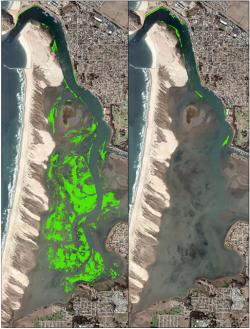
Eelgrass has mysteriously disappeared from the large tidal flats of Morro Bay, California, prompting a new research collaboration to investigate the reasons for the collapse, the potential adverse effects on local fish and wildlife, and how to bring the eelgrass back. Scientists hope what they learn will also help inform eelgrass recovery efforts up and down the West Coast. Eelgrass provides one of the richest and most productive coastal habitats in the world and is found in cold, shallow waters, primarily in the northern hemisphere. Halfway up the California Coast, Morro Bay has long been known for its vast beds of native eelgrass (Zostera marina), which help protect shorelines, improve water quality, sustain marine and estuarine food webs, and support many fish and invertebrate species. As one of many examples, threatened and endangered species such as steelhead benefit from the food-rich habitat and shelter that eelgrass provides.
Eelgrass provides one of the richest and most productive coastal habitats in the world and is found in cold, shallow waters, primarily in the northern hemisphere. Halfway up the California Coast, Morro Bay has long been known for its vast beds of native eelgrass (Zostera marina), which help protect shorelines, improve water quality, sustain marine and estuarine food webs, and support many fish and invertebrate species. As one of many examples, threatened and endangered species such as steelhead benefit from the food-rich habitat and shelter that eelgrass provides.
But something is happening to Morro Bay eelgrass. It has declined by 97 percent, from 344 acres in 2007 to about 13 acres by 2015. While natural cycles normally drive increases and decreases in eelgrass abundance over time, such catastrophic crashes are rare.
In 2014, NOAA Fisheries contributed to a major transplanting effort led by the Morro Bay National Estuary Program (MBNEP), to restore lost eelgrass habitat. This effort produced valuable scientific knowledge and brought the local community together, but recent monitoring indicates that little of the transplanted eelgrass survived.
While scientists assume water quality and environmental factors likely contributed to the loss, the exact cause of the overall disappearance remains unknown.
To investigate this mystery, a new research partnership has emerged. The Eelgrass Research and Monitoring Collaborative (ERMC) includes staff from NOAA Fisheries, California Sea Grant, MBNEP, California Polytechnic University (Cal Poly) professors and students, and the California Department of Fish and Wildlife. The group is looking into factors such as dredging, shoreline development, freshwater inflow, sedimentation, disease, overgrazing, and competition with macroalgae to determine the potential causes of the eelgrass decline.
"Partnerships like this one are vital to recovering Morro Bay eelgrass and the essential habitat it provides to many important species," said Brian Meux, who is coordinating the effort for NOAA Fisheries. "We are hopeful that together, we can shed some real light on this phenomenon to ensure the longevity of this estuary's important habitats and the others like it that are critical to the region."
"To solve a problem of the magnitude of loss of eelgrass in Morro Bay will take a whole community. The collaborative group is bringing together expertise and resources from all sectors because we cannot sit by while a major state ecosystem collapses," said Jennifer O'Leary, a marine ecologist with California Sea Grant and faculty at Cal Poly.
Over the next few months, the ERMC plans to release some preliminary findings and published articles that will shed new light on this puzzle and, ultimately, help launch a strategic restoration effort to revive Morro Bay eelgrass and the vast ecosystem it supports. "The knowledge we are gaining on the state of the remaining eelgrass, on bay water quality conditions, and on conditions that improve transplant success, will be critical to our future work to restore this valuable habitat in our bay," said Ann Kitajima, Assistant Director of the MBNEP.


 Advertising
Advertising